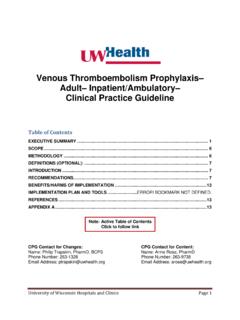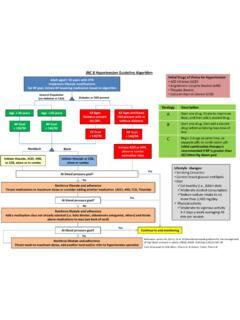Transcription of Guideline for the pharmacological treatment of …
1 Guideline for thepharmacological treatment of hypertension in adultsGuideline for thepharmacological treatment of hypertension in adultsGuideline for the pharmacological treatment of hypertension in adultsISBN 978-92-4-003398-6 (electronic version) ISBN 978-92-4-003397-9 (print version) World Health Organization 2021 Some rights reserved. This work is available under the Creative Commons Attribution-NonCommercial-ShareAlike IGO licence (CC BY-NC-SA IGO; ). Under the terms of this licence, you may copy, redistribute and adapt the work for non-commercial purposes, provided the work is appropriately cited, as indicated below. In any use of this work, there should be no suggestion that WHO endorses any specific organization, products or services. The use of the WHO logo is not permitted. If you adapt the work, then you must license your work under the same or equivalent Creative Commons licence.
2 If you create a translation of this work, you should add the following disclaimer along with the suggested citation: This translation was not created by the World Health Organization (WHO). WHO is not responsible for the content or accuracy of this translation. The original English edition shall be the binding and authentic edition . Any mediation relating to disputes arising under the licence shall be conducted in accordance with the mediation rules of the World Intellectual Property Organization ( ).Suggested citation. Guideline for the pharmacological treatment of hypertension in adults. Geneva: World Health Organization; 2021. Licence: CC BY-NC-SA (CIP) data. CIP data are available at , rights and licensing. To purchase WHO publications, see To submit requests for commercial use and queries on rights and licensing, see Third-party materials.
3 If you wish to reuse material from this work that is attributed to a third party, such as tables, figures or images, it is your responsibility to determine whether permission is needed for that reuse and to obtain permission from the copyright holder. The risk of claims resulting from infringement of any third-party-owned component in the work rests solely with the disclaimers. The designations employed and the presentation of the material in this publication do not imply the expression of any opinion whatsoever on the part of WHO concerning the legal status of any country, territory, city or area or of its authorities, or concerning the delimitation of its frontiers or boundaries. Dotted and dashed lines on maps represent approximate border lines for which there may not yet be full mention of specific companies or of certain manufacturers products does not imply that they are endorsed or recommended by WHO in preference to others of a similar nature that are not mentioned.
4 Errors and omissions excepted, the names of proprietary products are distinguished by initial capital reasonable precautions have been taken by WHO to verify the information contained in this publication. However, the published material is being distributed without warranty of any kind, either expressed or implied. The responsibility for the interpretation and use of the material lies with the reader. In no event shall WHO be liable for damages arising from its use. ContentsAcknowledgements vAcronyms and abbreviations viExecutive summary vii1 Introduction 12 Method for developing the Guideline Guideline contributors Analytical framework and PICOs Outcome importance rating Reviews of evidence Certainty of evidence and strength of recommendations Deciding upon recommendations Funding 63 Recommendations Blood pressure threshold for initiation of pharmacological treatment Laboratory testing before and during pharmacological treatment Cardiovascular disease risk assessment as guide to initiation of antihypertensive medications Drug classes to be used as first-line agents Combination therapy Target blood pressure Frequency of re-assessment Administration of
5 treatment by nonphysician professionals 194 Special settings hypertension in disaster, humanitarian and emergency settings COVID-19 and hypertension Pregnancy and hypertension 225 Publication, implementation, evaluation and research gaps Publication Implementation and dissemination Evaluation Future updating of the Guideline Research gaps 246 Implementation tools Guideline recommendations Drug- and dose-specific protocols 28 References 30 Annex 1: List of contributors 37 Annex 2. Managing declarations of interest and conflicts of interest 42 Annex 3: treatment outcomes relevant to hypertension 43 Annex 4: PICO questions 44 Web Annex A: Summary of evidenceWeb Annex B: Evidence-to-decision frameworkiiiGUIDELINE FOR THE pharmacological treatment OF hypertension IN ADULTSF iguresFig.
6 1 Analytic framework for antihypertensive medication treatment 3 Fig. 2 Framework for analysis 9 Fig. 3 An approach for starting treatment with a single-pill combination 26 Fig. 4 An approach for starting treatment not using a single-pill combination ( with monotherapy or free combination therapy) 27 Fig. 5 Algorithm 1 28 Fig. 6 Algorithm 2 29 Fig. Rating of outcomes 43ivAcknowledgementsThe Guideline for the pharmacological treatment of hypertension in adults was prepared by the World Health Organization (WHO) Department of Noncommunicable Diseases. The departments of HIV, Hepatitis and Sexually Transmitted Infections (HHS), Mental and Substance use Disorders (MSD), Medicines and health products (MHP), the regional offices for Africa (AFRO), South East Asia (SEARO), Europe (EURO) and Eastern Mediterranean (EMRO), and the Pan American Health Organization/Regional Office of the Americas (PAHO/AMRO) also contributed.
7 These departments were represented on the WHO Steering Group for this technical officer: Taskeen KhanWHO Steering Group members: Bernadette Cappello (MHP), Neerja Chowdhury (MSD), Gampo Dorji (SEARO), Jill Farrington (EURO), Taskeen Khan (NCD), Pedro Ordunez (PAHO/AMRO), Steven Shongwe (AFRO), Slim Slama (EMRO), Cherian Varghese (NCD), Marco Vitoria (HHS), Temo Waqanivalu (NCD). Guideline Development Group: WHO would like to thank the members of the Guideline Development Group (GDG) for their commitment, enthusiasm and expertise. GDG members were:Shrish Acharya (WPRO), Akram Al-Makki (AMRO), Hind Mamoun Beheiry (EMRO), Beatriz Champagne (AMRO), Ugyen Choden (SEARO), Kenneth Connell (AMRO), Marie Therese Cooney (EURO), Donald DiPette (AMRO), Nnenna Ezeigwe (AFRO), Tom Gaziano (AMRO), Agaba Gidio (AFRO), Vilma Irazola (AMRO), Patricio Lopez Jaramillo (AMRO), Unab Khan (EMRO), Vindya Kumarapeli (SEARO), Andrew Moran (AMRO), Margaret Mswema Silwimba (AFRO), Brian Rayner (AFRO), K.
8 Srinath Reddy (SEARO), Nizal Sarrafzadegan (EMRO), Apichard Sukonthasan (SEARO), Paul Whelton (AMRO), Jing Yu (WPRO). Methodologist: M Hassan Murad (Professor of Medicine at the Mayo Clinic, Rochester, USA)Systematic Review Team: Reem Mustapha, Abdallah Al Alayli, Romina Brignardello, Sara Jdiaa, Veena Manja (University of Kansas Medical Center, Kansas, USA)External Review Group: WHO is grateful for the contributions of the following individuals who peer-reviewed the draft Guideline :Mabel Aoun, Antoinette P ch re Bertschi, Jennifer Cohn, Prabhdeep Kaur, Daniel T Lackland, Venus Mushininga, Marcelo Orias, and Xin Hua Thomas from the WHO guidelines Review Committee Secretariat, and Nathan Ford, Chair of the guidelines Review Committee are gratefully acknowledged for their technical support throughout the process. Thanks are also due to Alma Alic from the Department of Compliance, Risk Management and Ethics for her support in the assessment of declarations of interests.
9 Sheila Nakpil from the Department of NCDs provided logistical would like to recognize the voices of persons with lived experiences with hypertension whom we heard from through consultation during development of this FOR THE pharmacological treatment OF hypertension IN ADULTSA cronyms and abbreviationsACE1angiotensin-converting enzyme 1 ACE2angiotensin-converting enzyme 2 ACEiangiotensin-converting enzyme inhibitorARBangiotensin-II-receptor blockerBBbeta-blockerBPblood pressureCADcoronary artery diseaseCCBcalcium channel blockerCKDchronic kidney diseaseCREWHO Office of Compliance, Risk Management and EthicsCVcardiovascularCVDcardiovascular diseaseDBPdiastolic blood pressureDMdiabetes mellitusDOIdeclaration of interestECGelectrocardiogramEMLE ssential Medicines ListERGE xternal Review GroupESRDend-stage renal diseaseGDGG uideline Development GroupGRADEG rading of Recommendations Assessment, Development and EvaluationHCWhealth care worker (nonphysician)
10 HIChigh-income countryHTNhypertensionLIClow-income countryLMIClow- and middle-income countryLV Hleft ventricular hypertrophyMACE major adverse cardiovascular eventMImyocardial infarctionMICmiddle-income countryNCDnoncommunicable diseasePENWHO package of essential NCD interventionsPICO population intervention comparator outcome QALY quality-adjusted life yearRAAS renin-angiotensin-aldosterone systemSBPsystolic blood pressureACRONYMS AND ABBREVIATIONSviExecutive summaryMore people die each year from cardiovascular diseases than from any other cause. Over three quarters of heart disease and stroke -related deaths occur in low-income and middle-income countries. hypertension or elevated blood pressure is a serious medical condition that significantly increases the risk of heart, brain, kidney and other diseases. hypertension can be defined using specific systolic and diastolic blood pressure levels or reported use of antihypertensive medications.














